Langtang Valley Trek - Highlights, Overview, Itinerary, Difficulty, Best Time to Go, Permits, Useful Information
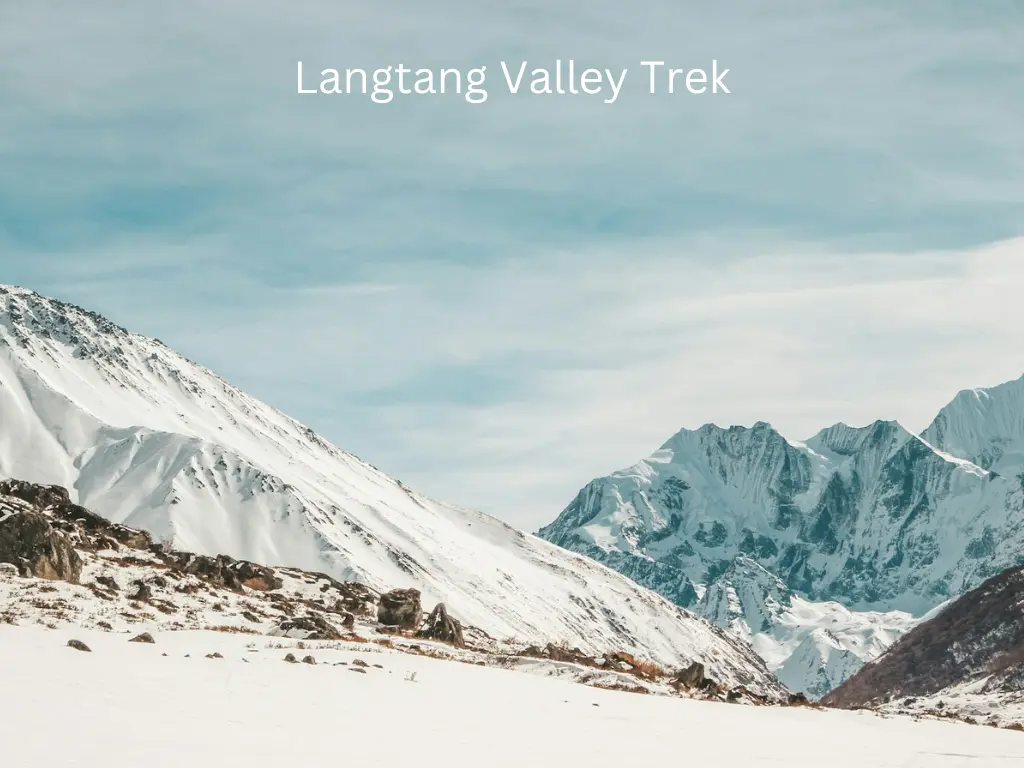
The Langtang Valley Trek is relatively short and runs through rhododendrons and bamboo forests alongside waterfalls and stunning snow-capped mountains. The trek is famous for providing stunning mountain views including Langtang Himalayan ranges, Buddhist Tibetan culture, and walking through the Langtang National Park.
The trail takes you to Tsergo Ri / Tserko Ri (4,985 m / 16354 ft) and Kyanjin Ri (4,773m / 15,655 ft), the highest points and one of the main highlights of the Langtang trekking.
The Langtang Trek starts and finishes in Syabrubesi, a small town 112 km northeast of Kathmandu, near the border with China. The trek takes 8-10 days to complete and can be extended by combining other treks in the Langtang region. You will find the 8-Day Langtang Trek itinerary in the blog. This Short 8-day Langtang Trek takes you to discover the unique local culture, varied landscapes, and natural beauties of the Langtang Himalayas.
The trek is considered 'Moderate' in terms of difficulty level and perfect starting trek for beginners. The trek is not physically demanding with a decent uphill climb until you reach Kyanjin Gompa. However, reaching Tesrko Ri, which is the highest point on the trek can be challenging. Anyone with a basic level of physical fitness can easily complete the trek.
Weather and climatic conditions play a huge role in trekking. However, the best time for the Langtang Valley trek is the months of March, April, May, September, October, and November characterized by Spring and Autumn seasons. Unlike every other trekking region in Nepal, the Langtang Valley trek also requires trek permits. TIMS card and Langtang National Park Entry permits are required for the trek.
The Langtang trek provides a basic type of accommodation in the form of small teahouses. Teahouses have small twin-sharing rooms with beds, mattresses, pillows, blankets, and a dining hall for serving meals. They provide electricity for charging devices and WI-FI services for a certain amount.
Langtang Trek Highlights
Spectacular Himalayan views: The Langtang Valley Trek offers stunning panoramic mountain views of Kimshug 6,781 m (22,247 ft), Langtang Lirung (7,234 m / 23733 ft), Dorje Lakpa (6,966 m / 22,854 ft), Langtang Ri (7,205 m / 23,638 ft) and many more.
Kyanjin Gompa: This picturesque Buddhist monastery is located at an altitude of 3,870 m / 12696 ft and is one of the major highlights of the trek. The monastery is surrounded by prayer flags and offers stunning views of the surrounding mountains.
Langtang National Park: The Langtang Valley is located within Langtang National Park, which is home to a variety of wildlife, including red pandas, snow leopards, and Himalayan tahr. The park also boasts a diverse range of flora, including rhododendron forests.
Tamang culture: The Langtang Valley is home to the Tamang people, a Tibetan Buddhist ethnic group. The trek offers a chance to learn about their culture and way of life.
Cheese Factory: A unique stop on the trek is a visit to a local cheese factory. Here you can taste the freshly made cheese and learn about the traditional process of making cheese from yak milk.
Side treks: Several side treks can be done from the Langtang Valley, such as a hike to Tsergo Ri (4,985 m / 16,354 ft) and Kyanjing Ri (4,780 m / 15,682 ft) for even more stunning views.
Langtang Valley Trek Overview
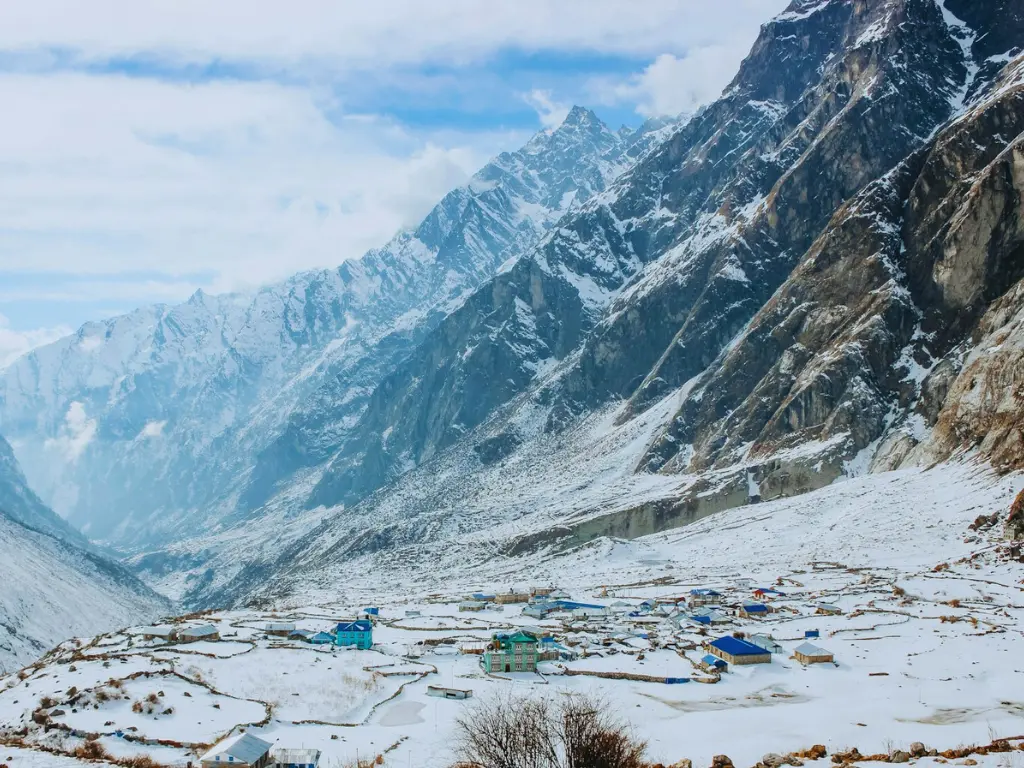
Langtang Valley also known as Lamtang Valley lies in the Rasuwa district of the Bagmati Province in Nepal. Langtang Valley is located about 80 kilometers north of the Kathmandu Valley. The valley lies within the Langtang National Park, which borders the Tibet Autonomous Region in Southwest China.
The local inhabitants of the Langtang Valley are Tamang People and they refer to each other as 'Langtangpa'. They generally follow Tibetan Buddhism and speak the Tibetan language. The ancient monastery, Kyanjin Gompa is considered a sacred pilgrimage site and learning center for Tibetan Buddhists. The spectacular mountain views on this trek include Dorje Lakpa (6,966 m / 22,854 ft), Langtang Ri (7,205 m / 23,638 ft), and Langtang Lirung (7,234 m / 23733 ft), the highest mountain of the Langtang range. Langtang Valley is also called "Glacier Valley"
The Langtang trail passes through Langtang National Park, a pristine area with beautiful floras and faunas, yak farms, and cheese factories. This area is home to Himalayan pheasants, deer, bears, monkeys, and the hard-to-find red panda.
Tourism in Langtang began in the 1970s, increasing economic opportunities for the locals. Langtang became a popular trekking destination due to its scenic natural landscape and stunning mountain views of Langtang Lirung and several glacial lakes in Langtang National Park. Langtang Valley was thought to be one of the most beautiful valleys in the Himalayas. It saw an average of 20,000 visitors a year, making it Nepal's third most popular trekking area.
Unfortunately, the village of Langtang was almost destroyed by a massive avalanche caused by the April 2015 Nepal earthquake. The locals have been rebuilding; teahouses and lodges have been rebuilt and opened in the new settlement.
The Langtang trek begins with a drive along the Trishuli River, north of Kathmandu to Syabrubesi. This route is an ancient trading route between Nepal and Tibet.
It will take you two days to reach Langtang Valley from Sybrubesi. You will be trekking from Syabrubesi to Lama Hotel on your first day. Then the next day from Lama Hotel, you will reach Langtang Village.
The next day we will trek to Kyanjin Gompa, your acclimatizing stop of the trek. During your acclimatization, you will explore the local ancient monasteries, visit the cheese factory, and hike to Tserko Ri / Tsergo Ri (4,985 m / 16354 ft) Viewpoint. The ascend takes up to 6-7 hours to reach the Tsergo Ri viewpoint and up to 3 - 4 hours to descend. This part of the trek can be challenging due to the strong wind and the time consumed to reach the top.
From the top of Tsergo Ri, trekkers can see stunning views of glaciers and a panoramic view of the Langtang mountain ranges like Langtang Lirung (7,234 m / 23,734 ft), Langtang Ri (7,205 m / 23,638 ft), Dorje Lakpa (6,966 m / 22,854 ft), Yala Peak (5,520 m /18,110 ft) and many more and Shishapangma mountain (8,027 m / 26,335 ft), 14th highest mountain in the world.
Another viewpoint is Kyanjin Ri which is at an elevation of 4,773 m / 15,655 ft provides majestic views of the entire Langtang Lirung face and Langtang Lirung Glacier below the peak.
After acclimatizing and exploration, you return to the Lama Hotel from Kyanjin Gompa trekking south and then back to Syabrubesi, marking the end of your trek. The next day you will take a bus back to Kathmandu. This is an enjoyable trek in which everyone should participate and experience its beauty at least once in their lives.
8 Days Langtang Valley Trek Day-to-Day Itinerary
Day 1: Kathmandu to Syabrubesi (Drive)
Drive Time: 6 to 7 hours
Accommodation: Tea House
Distance: 122 km / 75 miles
The trek to Langtang Valley starts from a 7-8 hour bus drive to the north-western side from Kathmandu.
The drive will take you along the Trisuli River and you may see rafters rafting on the mighty rapids. On the way, you get to see the impressive views of Annapurna I, Ganesh Himal, Jugal Himal, Manaslu, Langtang, and many other minor peaks. You will pass through small towns, villages, and several rivers while driving along the route.
Viewing the scenarios, you pass through Betrawati, then Dunche. It is around 15 km / 9 miles from Dhunche to reach Syabrubesi, where you will stay for the night.
Syabrubensi is a small beautiful village and the gateway to reach some of the best reks of Langtang Region. You will feel the fresh and cool air, with prayer flags everywhere.
Day 2: Syabrubesi to Lama Hotel
Trek Time: 6-7 hours
Accommodation: Tea House
Trek Distance: 11.3 km / 7 miles
From today, you will begin your walk to the Langtang Valley. After breakfast at Syabrubesi, you will get started by crossing a suspension bridge over the Bhote Koshi River that flows down from Tibet.
After continuing the walk, you will reach the Guru Rinpoche Gomba, where you pray for the trek.
Walking about a bit further, you cross a suspension bridge and do a gradual climb to Bamboo. It is a beautiful place situated in the canyon and has many guest houses near the Langtang Khola. After having your lunch in Bamboo you move ahead.
From here, the trail takes you through a beautiful subtropical forest covered with oaks, maple, rhododendrons, fir, and pines alongside Langtang Khola. You also get to witness various wildlife like wild boars, red pandas, langurs, Himalayan black bears, and yellow-throated martens.
After steady uphill climbs, you arrive at the Lama Hotel, your destination for the day. This spot is a popular rest point for trekkers.
Day 3: Lama Hotel to Langtang Village
Trek time: 7 hours
Accommodation: Tea House
Trek Distance: 14.7km / 8 miles
The trekking journey from Lama Hotel to Langtang Village is beautiful. Today you continue your trek alongside Langtang Khola by climbing through pine and rhododendron forests, passing several small remote villages, and rising above the watercourse of the Langtang Khola to reveal a splendid view of the Langtang Himal range.
Among the Langtang Himal range, Langtang Lirung is the highest, which sits at an altitude of 7,245 m / 23,769 ft above sea level. Following the path in the shadow of the mighty summit, you reach a log bridge that takes you across an abundant pasture of Ghoda Tabela at an elevation of 2, 992 m. Ghoda Tabela means a horse stable.
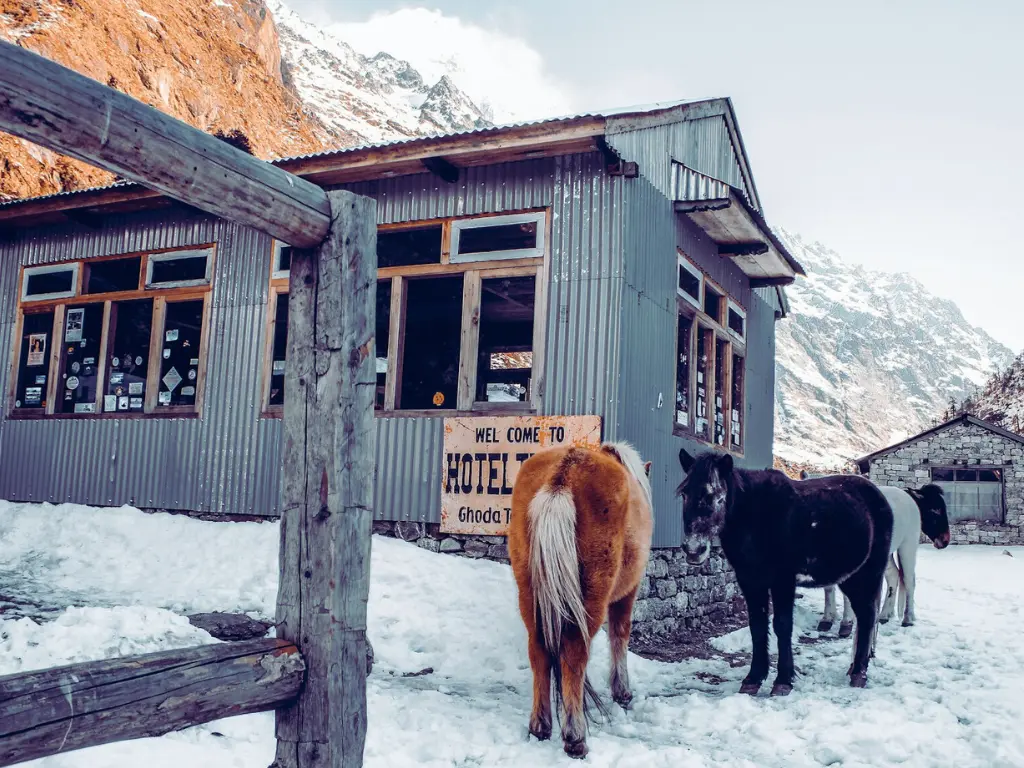
After having your lunch at Ghoda Tabela, you will hike along a path adorned with prayer wheels, water mills, and Mani Walls. You will walk through yak pasture and pass a helipad before briefly climbing through rhododendron forests to reach the Langtang village.
The Langtang Village was damaged completely during the 2015 earthquake but it has since been rebuilt.
Then crossing a stream on these trails, you settle at Langtang Village. This beautiful village has Tibetan-style houses with flat roofs and beautifully carved wooden windows.
Day 4: Lantang Village to Kanjin Gompa
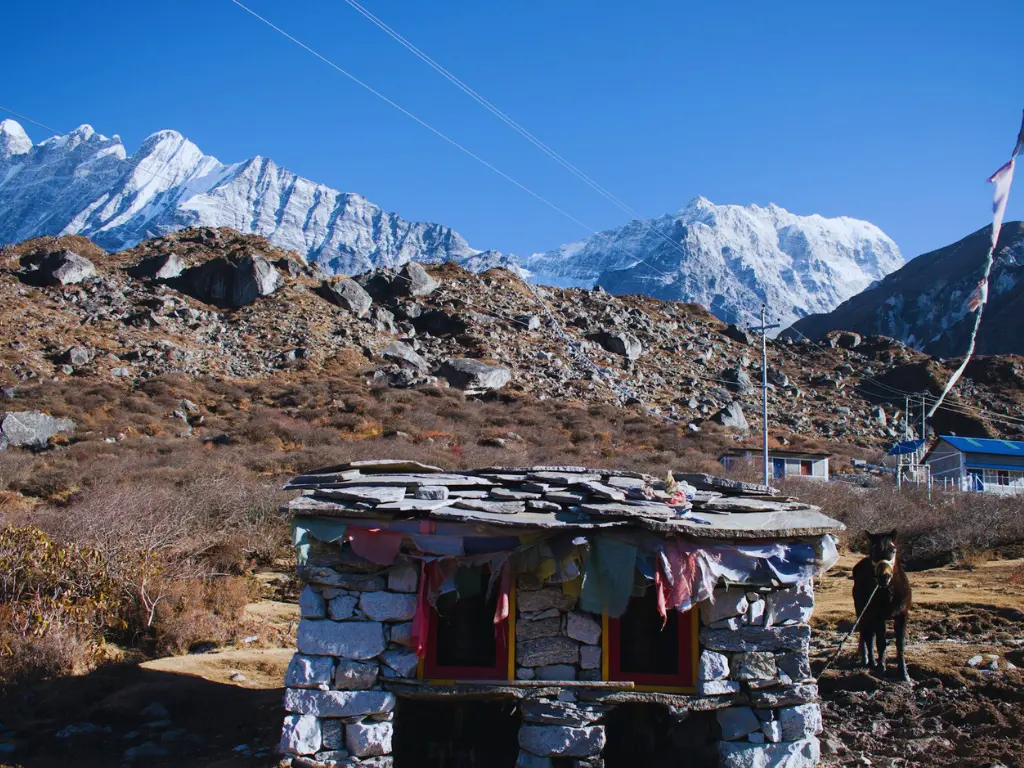
Trek Time: 6 hours
Accommodation: Tea House
Trek Distance: 5.7 km/ 3.5 miles
Today you head towards Kyanjin Gompa from Langtang Village, which is a few hour's hike. After having breakfast you continue your hike to Kyanjin Gompa.
The trail starts by walking along the Mani Walls and climbing a ridge. Then doing gradual climbs, you pass the beautiful prayer flags and cross a river to reach Mundu at 3,543 m.
You pass through several wooden bridges and moraines. Walking ahead, you get the view of Kyanjin Gompa and the stunning peaks of Kimshug 6,781 m (22,247 ft) and Langtang Lirung (7,245m / 23,769 ft).
After continuing the hike, you finally arrive at Kyanjin Gompa, the last place with tea houses. This place is also famous for its cheese factory that offers yak and curd. The village offers a panoramic view of Dorje Lhakpa, Langshisha Ri, Ganja La, Tsergo Ri, and more.
Day 5: Kyanjin Gompa to Tsergo Ri to Kyanjin Gompa
Trek Time: 5 to 6 hours
Accommodation: Tea House
Today you hike up to Tsergo Ri, one of the major highlights of the Langtang Valley Trek.
After having your breakfast, you hike up to Tsergo Ri, the highest point of the trek.
From this point, you get to see the entire Langtang ranges, Kinshung, Yansa Tsenji, and more. After spending some time here you return to Kyanjin Gompa and stay overnight there.
Day 6: Kyanjin Gompa to Lama Hotel
After bidding farewell to Kynajin Gompa, you retrace your path back to the Lama Hotel. As you will be descending today, the walk will be comfortable and easy.
You will pass by familiar yak herding settlements and wide alpine pastures as you lose about 1,400 meters throughout your descent. After continuing your path, you will finally reach Lama Hotel, your destination for the day.
Day 7: Lama Hotel to Syabrubesi
Trek Time: 6 hours
Accommodation: Tea House
Trek Distance: 11.3 km /7 miles
Today is the final day of your trek as you reach Sybrubesi from where you started the Langtang Valley Trek.
You will have two routes to consider for today’s trek. The first option is the same way you walked earlier descending through the pine forest to pass Bamboo and Renche before reaching the Bhote Khola river crossing.
The second one is a steeper option that offers splendid views of the Langtang Valley and the chance to explore a new trail that goes via Rimche and Sherpa Gaun in the Langtang region instead of retracing our steps.
Day 8: Syabrubesi to Kathmandu (Drive)
Finally, the trek journey to Langtang Valley ends as you head back to Kathmandu by road. You drive back, passing through terraces, local settlements, rivers, high hills, and more.
How Difficult is Langtang Valley Trek?
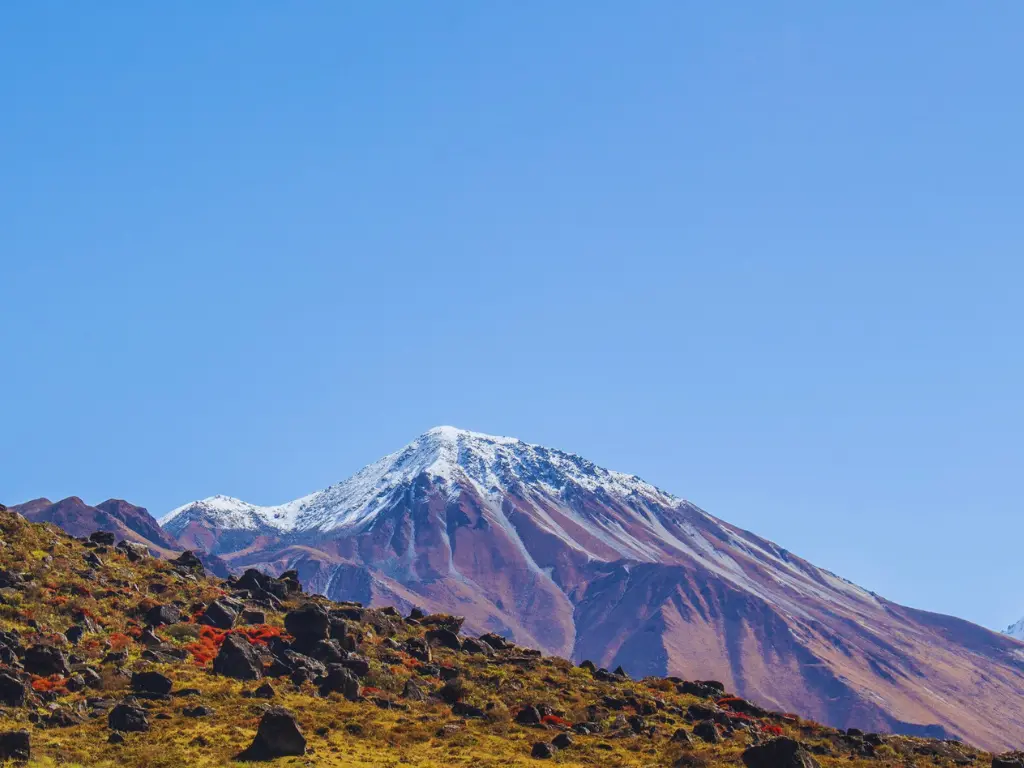
Langtang Valley Trek is a moderately difficult trek. The trek is short and perfect for beginner trekkers to start the trekking journey as it does not demand any trekking or mountaineering expertise. This short-duration trek has well-defined paths and many tea houses with good food and accommodations which makes it easily accessible to trek for everyone.
However, you should have a good and basic level of physical fitness required for the trek.
Which Month is the Best Time for the Langtang Valley Trek?
Spring months (March, April, and May) and Autumn months (September, October, and November) are the best time for Langtang Valley Trek.
Spring is the season of colors and joy and nature is at its best during this season. The temperature is mild, the skies are clear with astounding Himalayas views. You will see the wildflowers and rhododendrons come into full bloom.
During Autumn months the weather is stable and the skies are clear which allows for breathtaking panoramic views of the surrounding Himalayan peaks.
What are the Permits Required for the Langtang Valley Trek?
You need 2 permits for the Langtang Valley Trek. They are:
TIMS Card (Trekkers' Information Management System)
As per the Revised TIMS Provision implemented from March 31, 2023, trekkers trekking in specific Protected Areas of Nepal need be accompanied by a licensed trekking guide and carry a trekking agency-issued TIMS Card.
TIMS Card is mandatory in most of the trekking regions in Nepal
Langtang National Park Entry Permit
Every protected region in Nepal requires an entry permit. As you will be trekking in the Langtang National Park, you must get a permit by paying the entrance fee.
Useful Information on the Langtang Valley Trek
What Kind of Accommodations and Foods are Available on the Langtang Valley Trek?
Food and accommodation are not a major problem during the Langtang trek, you can find good tea houses and quality food during the trek.
Accommodation
Tea houses are the most common type of accommodation on the Langtang Valley Trek. These are small lodges that offer basic rooms, meals, and services.
The rooms are usually twin-sharing with small wooden beds, mattresses, pillows, and blankets. You may find rooms with attached bathrooms depending upon the location, while most teahouses have common bathrooms outside.
The locals and the authorities from Langtang National Park have fixed the accommodation prices in the teahouses from Syabru Besi to Kang Jin Gompa. Usually, they charge you $5-$10 per night.
Most tea houses offer a hot shower. However, hot showers are only sometimes available because they are usually solar-generated. A large bucket of hot water costs around NPR 200/US$1.5 and is enough for two people to take a bath.
Foods
The cuisine is determined by the local trekking committee of Langtang region and is the same from Syabrusi to Kyanging Gompa.
Morning Breakfasts – Varieties of Bread and Chapati (with jam, yak cheese, honey, peanut butter, omelet), Garlic omelet, boiled omelet, Onion omelet, Porridge and Puddings, Pancakes, fresh soups (Garlic Soup, Sherpa Stew, Tomato Soup, Mushroom Soup, Mixed Soup, Potato soup, Onion Soup) and options of Packet soup (chicken soup, tomato soup, mushroom, noodle soup).
Hot Drink Options - Black tea, Black coffee, Hot milk, milk tea, ginger tea, Masala tea, Ginger tea, Hot chocolate, Lemon tea, etc.
Lunch Options – Dhal, Bhat & Tarkari (with both veg and non-veg options), Sandwich (egg sandwich, veg sandwich), Dumplings (Momo), Pasta and Macaroni (Veg fried pasta, Cheese fried pasta, Pasta with cheese and tomato sauce, Plain macaroni, Macaroni with vegetables, cheese, and egg, Mix macaroni), Chowmein, Spaghetti, Pizza (veg pizza, chicken pizza, mushroom pizza, mixed pizza, etc).
Dinner Options – Popular nepal dish Dal (lentils), Bhat (Rice) & Tarkari (Curry), Dumplings (Momo), Macaroni Dishes, Spaghetti, Thukpa, Pasta, Vegetable Curry, Potato Items, Pizza, Snacks, Papad, Prawn, Korean Ramen, Rice Pudding, Apple Pie etc.
The dinner options are similar to the lunch menu. Most trekkers choose Nepali Dal Bhat options.
Mobile Network Coverage and Internet in the Langtang Trek
Langtang Valley Trek has network coverage till Kyanjin Gompa. NTC and NCELL network providers offer coverage in the Langtang region, but the signal strength and coverage area may vary. Mobile network coverage is good on the lower section of the trek to the Lama Hotel.
As you ascend higher especially beyond Langtang Village and towards Kyanjin Gompa, the mobile network coverage may become weaker or even non-existent at some point.
Some teahouses have satellite phones and Wi-Fi services, but they may come with additional charges. Most teahouses have WI-FI cards for 200 MB to NPR 500 / US $4 and 1 GB for NPR 1000 / US $8.
How is the Availability of Electricity and Water in the Langtang Valley Trek?
Electricity and Water is easily available in the Langtang Valley Trek.
The majority of electricity in the high-altitudes is generated by solar energy. Due to this, the power available has a low voltage. It may also not be available on cloudy days.
However, the electricity usage comes with an extra charge. If you want to charge your mobile phones or camera batteries, teahouses will charge you around $2 to $3.
Water is easily available in the teahouses and en-route shops. Using a water purifier is recommended and not drinking directly from any water source you find on the trek route. Teahouses charge a certain amount for hot water.
FAQs
What is the Highest Point on the Langtang Valley Trek?
The highest point on the Langtang Valley Trek is Tsergo Ri (4,985 m / 16354 ft) and Kyanjing Ri (4,780 m / 15,682 ft).
Is the Langtang Valley Trek Suitable for Beginners?
Yes, the Langtang Valley Trek is suitable for beginners. The trek is relatively short with a decent steep climb.
When is the Best Time For Langtang Valley Trek?
The best time for the Langtang Valley Trek are the Spring season (March-May) and the Autumn Season (September-November).
How Long is the Langtang Valley Trek?
The Langtang Valley Trek in Nepal is 7-10 Days long. But the trek can be extended by combining other Langtang region treks.
Where does the Langtang Trek Start?
The Langtang Trek starts and finishes in Syabrubesi, a small town 120 km northeast of Kathmandu, near the border with China.
Do Nepalese Require Permit for Langtang Trek?
Yes, Nepalese require a permit for Langtang Valley Trek. The Langtang National Park entry permit is required for all trekkers to enter the Langtang region.
Nepalese do not need a TIMS Card for the Langtang Trek.
Is Langtang Trek Safe?
Yes, the Langtang trek is safe for everyone and is considered perfect for novice trekkers. However, the concern of altitude sickness is always there whenever you are trekking to high-altitude regions in Nepal
